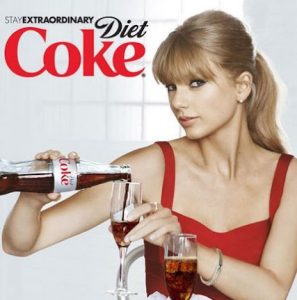Written By: Emily Sheng
Edited By: Koneenika Datta
Designed By: Jiya Mehta
Published By: Maryam Khan
 Oftentimes when shopping for food or going out for dinner, you are hit with an array of colours, symbols and words. An advertisement promising 99 cent ice cream may entice you. The bright jewel colours of the sodas in a convenience store make you thirsty. Perhaps your child had wanted to buy a certain meal because it had a fun toy inside. This fairly normalized aspect of our lives is known as food marketing. Food marketing is the process of advertising certain food products to consumers to increase sales and demand. While some forms of marketing can be very obvious to spot, others are concealed in a well crafted disguise that can influence how you perceive certain food products and which ones you purchase. Food marketing has been up and around for a very long time because of its effectiveness and ability to target certain audiences’ weaknesses and hook them in. Sometimes, the influence of food marketing can cause you to make poor decisions, affecting your health or the health of others.
Oftentimes when shopping for food or going out for dinner, you are hit with an array of colours, symbols and words. An advertisement promising 99 cent ice cream may entice you. The bright jewel colours of the sodas in a convenience store make you thirsty. Perhaps your child had wanted to buy a certain meal because it had a fun toy inside. This fairly normalized aspect of our lives is known as food marketing. Food marketing is the process of advertising certain food products to consumers to increase sales and demand. While some forms of marketing can be very obvious to spot, others are concealed in a well crafted disguise that can influence how you perceive certain food products and which ones you purchase. Food marketing has been up and around for a very long time because of its effectiveness and ability to target certain audiences’ weaknesses and hook them in. Sometimes, the influence of food marketing can cause you to make poor decisions, affecting your health or the health of others.
 Food marketing exists in a variety of forms. The most basic ones are the commercials seen on the internet, television, radio, magazines, social media, or even on the labels of the product itself. Companies use a variety of sensory effects such as visually bold colours, aesthetic product images, upbeat music, and striking phrases to catch your attention and get you interested in their food product. These advertisements can be directed to a certain general audience based on age or gender or it can be specifically targeting an individual through the use of personal data such as online browsing history.
Food marketing exists in a variety of forms. The most basic ones are the commercials seen on the internet, television, radio, magazines, social media, or even on the labels of the product itself. Companies use a variety of sensory effects such as visually bold colours, aesthetic product images, upbeat music, and striking phrases to catch your attention and get you interested in their food product. These advertisements can be directed to a certain general audience based on age or gender or it can be specifically targeting an individual through the use of personal data such as online browsing history.
 Product placement in movies, television shows, music videos, or video games is also a popular type of food marketing. A branded food or drink product can get a few seconds of screen time next to your favourite character and get some recognition and association with beloved characters. They are integrated well into the media and are put in a positive light while also being able to target a large audience. An example of a famous food product placement is the association of Reese’s Pieces with the movie E.T. Soon after the movies were released, there was a 65% increase in sales of the chocolate.
Product placement in movies, television shows, music videos, or video games is also a popular type of food marketing. A branded food or drink product can get a few seconds of screen time next to your favourite character and get some recognition and association with beloved characters. They are integrated well into the media and are put in a positive light while also being able to target a large audience. An example of a famous food product placement is the association of Reese’s Pieces with the movie E.T. Soon after the movies were released, there was a 65% increase in sales of the chocolate.
 Another extremely effective form of food marketing is celebrity endorsements. A popular singer, actor, or influencer will promote a certain branded food product, perhaps even forming a collaboration with the company to launch a new product line, which will put that product in a positive light. The die-hard fans of these celebrities or those who are simply just curious will be influenced and encouraged to purchase the food product, increasing sales as well as building brand loyalty.
Another extremely effective form of food marketing is celebrity endorsements. A popular singer, actor, or influencer will promote a certain branded food product, perhaps even forming a collaboration with the company to launch a new product line, which will put that product in a positive light. The die-hard fans of these celebrities or those who are simply just curious will be influenced and encouraged to purchase the food product, increasing sales as well as building brand loyalty.
Trends that arise from social media can also influence what foods you decide to purchase and consume. The power of peer-pressure and wanting to remain a part of a collective community can be very strong, which leads to trend following, even if they may not necessarily be very healthy, practical, or good for the environment.
Food marketing is very prevalent in our society today and its influence is quite effective. It can become problematic if our choices are being swayed away from healthy food choices and towards foods that contribute too much saturated fat or sugars to our diet. Because of this, it is important to recognize and acknowledge the effects of food marketing. Instead of letting these marketing strategies decide your diet, look at the food labels and nutrition facts to make active decisions about whether a food is healthy for you. Limit your exposure to advertisements and critically think about why you want to purchase a certain food. Most importantly, educate young children and adolescents on the effects of food marketing as those who are vulnerable tend to succumb to the influence of marketing more often. Take control of your diet and your lifestyle today to make more mindful food choices for the future.
References
Chavarria, Amilcar. n.d. “Product Placement: Definition, How It Works, Examples.” Investopedia. Accessed February 18, 2023. https://www.investopedia.com/terms/p/product-placement.asp.
Damstrom, Seamus. 2022. “Food marketing: How are you being influenced? | Stories.” Northern Health Stories. https://stories.northernhealth.ca/stories/food-marketing-how-are-you-being-influenced.
Haigney, Sophie. 2022. “Anatomy of a Product Placement.” The New York Times. https://www.nytimes.com/interactive/2022/06/23/arts/product-placement.html.
Malaj, Juxhina. 2022. “Product Placement: Definition & 40 Famous Examples.” MarketSplash. https://marketsplash.com/product-placement/.
“Marketing can influence your food choices – Canada’s Food Guide.” 2020. Canada’s Food Guide. https://food-guide.canada.ca/en/healthy-eating-recommendations/marketing-can-influence-your-food-choices/.
Image citations (in order of appearance):
- Hu Jiarui on Unsplash
- Annie Spratt on Unsplash
- Slashfilm, https://www.slashfilm.com/575405/the-morning-watch-netflix-product-placement-creating-the-skeksi-of-dark-crystal-more/
- Hollywood Branded, https://blog.hollywoodbranded.com/top-celebrity-beverage-endorsements

